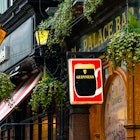
These lesser-known Dublin museums might be the cityтs best
Mar 15, 2022 тЂ 7 min read

The General Post Office on OтConnell Street in Dublin played host to seminal events in 1916тs Easter Uprising. Today, it hosts a museum celebrating this history тТ and remains the headquarters of the national An Post ТЉ David Soanes Photography / Getty Images
Dublin is home to the most museums in all of Ireland, with nearly 40 spread across the city.
The Irish capital boasts many of the countryтs most notable тnationalт collections т the (for art), the National Museum (for archeology), the National Library (for rare books) т and each of them very much merit a visit. Yet the best museums to really understand the character of the city and indeed the country range farther afield, offering exhibits covering such topics as emigration, the Viking era, the Easter Rising and a famous literary genius.
Here are our picks of the best museums in Dublin.
Anyone with Irish roots will love EPIC The Irish Emigration Museum
With some 10 million having left the island since 1800, the Irish form one of the worldтs great diasporas т and itтs worth spending some time to contemplate how this story of emigration has shaped both the wider world and Ireland itself. EPIC showcases the stories, successes and struggles this vast community has faced, and proves that emigration is not always about what people leave behind, but rather what they bring from their native country to new frontiers.
Set in the vaults of the splendid Custom House building, this interactive, award-winning museum has 20 interconnecting galleries detailing different migration-related themes from throughout Irelandтs history, including up to the present day. Visitors will learn about more than 300 of the countryтs proudest exports, and their achievements across entertainment, sports, politics, literature, art, fashion and science. Ever wondered about your own Irish heritage? Visitors can trace their family ancestry at the Irish Family History Centre located within the museum: book one-to-one appointments in-person, or even schedule a video conference call from home.
Dublinia vividly evokes the cityтs ancient past
This fun museum lets visitors travel back to the cityтs literal foundations, to the time of the Vikings and their medieval descendants. Todayтs modern metropolis was originally a Viking settlement known as Dubh Linn (which loosely translates to тblack poolт) built on the banks of the what we today call the River Liffey. Explore what life was like on board a Viking warship, marvel at these warriorsт weaponry and even try on their clothing as you immerse yourself in the myths and mysteries, sights, sounds and even smells of Viking and medieval Dublin.
A special combination ticket (only available for purchase at Dubliniaтs on-site ticket desk) grants additional access to Christ Church Cathedral and its incredible medieval crypt via a striking neo-Gothic archway connecting the two spaces. And donтt leave Dublinia without climbing the 96 steps of the original medieval tower for a spectacular view of the city.
After your visit, we recommend going across the road afterward to order some proper chips at Leo Burdockтs, followed by a pint at The Lord Edward next door.

Many cultures come to life at the Chester Beatty Library
Set within the historic grounds of Dublin Castle, the Chester Beatty Library promotes the understanding and appreciation of world cultures and religions. Philanthropist Alfred Chester Beatty bequeathed his private collection of more than 20,000 objects to the Irish State in 1968; today, the galleries here open with an overview of the collectorтs life before showcasing masterpieces from Mughal India, Persia, the Ottoman Empire, Japan and China. On the second floor, visitors can learn about the rites, rituals and sacred texts of major world religions through exquisite objects, including ancient Egyptian papyrus scrolls and one of Europeтs finest collection of Qurans.
Youтre sure to encounter memorable pieces wandering around by yourself т though free, informal, hour-long guided tours for small groups are available on Wednesdays, Saturdays and Sundays. (These must be booked in advance.) A visit isnтt complete without making your way to the Silk Road CafУЉ in the libraryтs atrium, which was built as a clock tower in the 18th century. True to its name, the cafe offers a menu with heavy Middle Eastern and Mediterranean influences, with many vegan, vegetarian and gluten-free options.
The GPO Witness History Museum tells the story of Irish independence
The 1916 Easter Rising set in motion the chain of events that led to the creation of the Republic of Ireland. Located on OтConnell Street, the Northsideтs main thoroughfare, the General Post Office (GPO) was the key bastion and command center for this seminal rebellion. Today, itтs a place of commemoration and a symbol of Irish freedom т while still functioning as the headquarters of the countryтs postal service.
The GPO Witness History Museum opened in 2016 to coincide with the Risingтs centenary. The hour-long, self-guided exhibition brings this fascinating history to life through testimonials and memorabilia from ordinary and notable Dubliners of the era. The centerpiece screening, which puts visitors at the heart of the action, is not to be missed.

Exciting contemporary art and a one-of-a-kind studio installation await at Hugh Lane Gallery
Opened in 1908 by Cork-born gallerist Hugh Lane in a beautiful mid-18th century Georgian mansion on Parnell Square North, this groundbreaking museum is the worldтs oldest public gallery for modern art. Over the last century, both the space and collection have been continually enhanced, updated and expanded.
The highlight here is the Francis Bacon Studio, an assemblage of more than 7000 of the artistтs objects that exactly recreates the artistтs chaotic workspace in London. The gallery also displays the gift of eight abstract paintings by acclaimed Irish artist Sean Scully, as well as Harry Clarkeтs resplendent stained-glass depiction of The Eve of St Agnes. Exploring Dublin on a Sunday afternoon? Pop in for one of the free public tours led by a team of art historians.
Ordinary Dubliners are the curators at the Little Museum of Dublin
With an enviable location right on St Stephenтs Green, one of Dublinтs smallest museums has a big heart and buckets of personality. Set in a handsome 18th-century Georgian townhouse, this award-winning attraction is made up of diverse donations from the public, which together tell the story of the city through the 20th century.
A somewhat chaotic mishmash of memorabilia has been carefully curated to reflect the vibrant, multicultural city Dublin has become. The popular, hourly guided tours are always entertaining and add more context and depth to your encounter with the collection. Whatтs more, every day at 11:30am the museum expands outdoors, with a Green Mile Walking Tour of St Stephenтs Green.

Уras an UachtarУЁin offers a glimpse into the halls of power
Even many Dubliners arenтt aware that there are weekly tours inside the president of Irelandтs official residence. Though not as palatial as certain of its European counterparts, the Уras an UachtarУЁin (тhouse of the Presidentт) is remarkably for its subtle architecture and superb setting: on Chesterfield Ave within the Phoenix Park, one of Europeтs largest enclosed city parks.
Dating back to the middle of the 18th century, the building has been used as both the presidential office and private residence by every president of Ireland since 1938. The 75-minute guided tour offers a unique chance to experience the main reception and state rooms. Free of charge, the tours run several times most Saturdays, but are strictly offered on a first-come-first-served basis. Take your chances turning up at the Phoenix Park Visitor Centre and you may get lucky;
If you miss out on a space, take advantage of the other options on offer in the expansive Phoenix Park: take a trip to Dublin Zoo; admire the largest obelisk in Europe, the 62m-tall Wellington Monument; or spot some of the herd of wild fallow deer (originally the space was used as a royal hunting park). On a sunny day, the Phoenix Park is also perfect for an impromptu picnic.
The Museum of Literature Ireland (MoLI) is perfect to visit on Bloomsday (or any day)
An essential stop for fans of James Joyce, this museumтs permanent collection centers on different aspects of the modernist masterтs work and includes тCopy No. 1т of Ulysses. Other groundbreaking authors get a spotlight in the temporary exhibitions, which recently included shows on Samuel Beckett and Nuala OтFaolain.
Why, you might wonder, is the lowercase тoт included in the abbreviation of the name of the museum? Well, instead of just abbreviating to MLI, MoLI pays a fitting homage to a certain Molly Bloom.
You might also like:
Where to find 'read' traditional Irish music in Dublin
Best places to eat in Dublin in 2022
The top 25 things to do in Dublin
Explore related stories



 Festivals & Events8 of the best cities in Europe to celebrate New Yearтs Eve
Festivals & Events8 of the best cities in Europe to celebrate New Yearтs EveNov 6, 2024 тЂ 7 min read

 AttractionCoasts, Castles and Culture: Nine days on Irelandтs Wild Atlantic Way
AttractionCoasts, Castles and Culture: Nine days on Irelandтs Wild Atlantic WayMay 20, 2024 тЂ 12 min read


 Festivals & Events8 of the best places to celebrate St Patrick's Day outside of Ireland
Festivals & Events8 of the best places to celebrate St Patrick's Day outside of IrelandMar 13, 2024 тЂ 6 min read
 Festivals & EventsSt Patrickтs Day 2024 in Dublin: everything you need to know
Festivals & EventsSt Patrickтs Day 2024 in Dublin: everything you need to knowFeb 23, 2024 тЂ 6 min read
